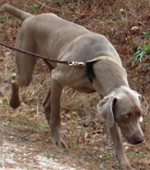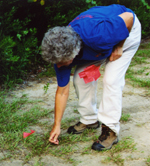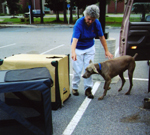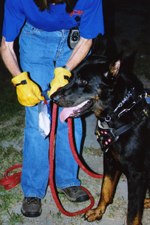Trained to track
Story
and photos by Heather Woolwine
Barbara Glover, Enrollment Management’s director for office operations, never predicted that caring for her dog would turn into coordinating the South Carolina Search Dogs (SCSD).
 Glover, facing
group, and members of SCSD discuss the previous training session and
decide what to work on.
Glover, facing
group, and members of SCSD discuss the previous training session and
decide what to work on.It all began out of love for her dog Carl, and the knowledge that his breed, Weimaraners, are an intelligent group who become bored easily without enough to do.
“I’ve always loved dogs and horses and had an appreciation for what they could do when paired with the right handler/owner. When I got Carl, I joined the Charleston Dog Training Club to begin obedience work with him so he and I could communicate the best that we could,” Glover said. “I had heard from a friend about American Kennel Club (AKC) tracking classes and met the other members of our group there. When it became apparent that a number of us were interested in working with our dogs in search and rescue, we began to train seriously and formed SCSD. As we advanced through our training, it became apparent that having a second dog would be worthwhile, so that’s when I decided to go back to the same family where I’d found Carl and get Ellie, his younger sister.”
 Ellie follows a
mock victim's trail in Francis Marion National Forest.
Ellie follows a
mock victim's trail in Francis Marion National Forest.Glover now works with Carl, Ellie, and the group of dogs and handlers that make up SCSD at least twice a week, and some individuals in the group work with their dogs more often. The group hosts several different breeds including Glover’s Weimaraners, two black Labrador retrievers, a couple of German shepards, a bloodhound, and even a beauceron, a French herding dog.
Training the animals takes a few hours each session and sites range from the parking lot, surrounding buildings and fields of West Ashley High School to the dense Francis Marion National Forest towards Georgetown. Training in a variety of locations is important, as the group never knows where they might be called in to search for someone.
Glover is training her dogs to become very good at being scent specific, meaning that given an article of someone’s clothing, a shoe, or even smelling the car seat that someone sat in, they can find a person based on that original scent article. “I’ve trained Carl and Ellie at home with my grandchildren. The children hide and then we use a scent article, such as a sock or toy from one of them to allow the dogs to begin the search,” she said. “Unlike the air scenting dogs in our unit who work off the leash, my dogs work on a long lead and harness which allows them to follow a track fairly independently.”
 Glover marks turns
in a scent track so Abby's handler will know if she's tracking
correctly.
Glover marks turns
in a scent track so Abby's handler will know if she's tracking
correctly.During training, different teams of dogs and handlers work on a variety of exercises designed to test and train each dog/handler team based on its individual level of confidence, maturity, and acquired skill. Some of those exercises include mock searches where “victims” hide in various locations after leaving behind a scent track, deciphering who in a small crowd matches a scent article, and obedience training necessary for search and rescue. Boy Scouts from a Mt. Pleasant troop volunteer as mock victims while working on badge requirements.
Sometimes training can be spur-of-the-moment, as Glover found out when she went to visit her granddaughter’s school class for show-and-tell. “I was explaining to the children what Carl does when he looks for someone and the next thing I know, my granddaughter Sarah says, ‘Here’s my pocketbook Carl, come find me!’ She ran out of the room and proceeded to go hide. I explained to her teacher that this wasn’t supposed to be part of the show but her teacher said she’d love to see it if we were up for it. I gave Carl the scent article again and then he led us to her, through the numerous parents, children and chaos that had gathered for a field trip. She had hidden at the other end of the building, behind a stack of books in the library, and sure enough, he found her.”
 This device reports
wind, speed, humidity, and temperature.
This device reports
wind, speed, humidity, and temperature.To ensure that mock victims or teams don’t become lost themselves during practice or a real search and rescue call, each team member carries a portable GPS tracking system that can be uploaded with maps of a particular area, as well as serving as a radio communication device. The teams are outfitted with other nifty tools as well, including a gadget that can report wind speed, humidity, and temperature. “This device is very helpful in showing us which dogs perform best in certain kinds of weather or temperatures,” Glover said. “Some perform best in cool or cold weather and others are fine in the heat. It’s helpful when you receive a call and can factor that information in when deciding which teams would be best suited for the job.”
As a member of the Charleston County Emergency Response Team (CERT), Glover received one call for help from SCSD so far, regarding a person who was missing for more than 15 hours in Dorchester County. “They had been looking for her for hours, so we dispatched three teams. They found her in eight minutes.”
 Glover directs Carl
into a canvas kennel where he can safely wait for his turn to train.
Glover directs Carl
into a canvas kennel where he can safely wait for his turn to train.Glover outlined the group’s requirements as in compliance with the National Association of Search and Rescue technical titles and said that each handler must obtain at least two of them. Search And Rescue (SAR) Tech level III is 40 hours worth of training that volunteers must attend without a dog, usually on the weekends. SAR Tech II is again completed without dogs but volunteers must learn GPS and compass reading skills, knot tying, and how to camp out, hike, and carry everything needed for a volunteer and a canine companion in a 40 pound pack. SAR Tech I teaches volunteers to become instructors in search and rescue protocol.
From there, more courses are added that involve the dogs directly and require travel to other states like Alabama, North Carolina, and Tennessee because no one in South Carolina is qualified to teach those particular courses.
 Abby receives a
treat after she successfully located Barbara Glover.
Abby receives a
treat after she successfully located Barbara Glover.A new addition to search and rescue preparation is hazardous materials training, because it’s not uncommon to run across evidence of meth labs in South Carolina’s forests. “The training teaches you what to look for, what certain trash items might mean, and how to respond to finding a suspicious place,” Glover said.
In addition to SAR and Hazmat training, group members work toward K9 Good Citizen Certification, an AKC test to ensure dogs are sociable, non-aggressive, and obedient. “They have to sit and stay with strangers, handle loud noises without barking or crying, walk comfortably on a lead, and control themselves around other dogs,” Glover said. “They have to be people oriented dogs to be involved in search and rescue and they need to be obedient because you want to be able to keep them out of danger. Carl recently completed all of his obedience training and pre-certified in tracking/trailing. Ellie has received her tracking pre-certification and right now we’re working on her obedience training.”
In addition, members of SCSD must know K9 and human first aid, CPR, and attend Red Cross courses that cross over into CERT qualifications. In the coming months, various experts from around the country will visit the Lowcountry to teach the group more about search and rescue techniques.
Others might think that with all the training required for search and rescue, it becomes more work than fun. And although they may be right about it being hard work, the handlers and dogs do have a good time together, and with the promise of using the training for an altruistic purpose.
“When I think about someone being lost, whether it is a child or an Alzheimer’s patient, I believe that training these dogs and having them ready provides a great service to our community and at the same time the challenging activities are good for all of us,” Glover said.
On The Side
MUSC is full of people who do extraordinary things, both at work and “On the Side.” Whether it's climbing a mountain or volunteering in the community, we'd like to know what these folks are up to when they leave the campus. If you know of someone who should be featured in this monthly section, call Heather Woolwine at 792-7669 or e-mail woolwinh@musc.edu
Friday, Aug. 5, 2005
Catalyst Online is published weekly,
updated
as needed and improved from time to time by the MUSC Office of Public
Relations
for the faculty, employees and students of the Medical University of
South
Carolina. Catalyst Online editor, Kim Draughn, can be reached at
792-4107
or by email, catalyst@musc.edu. Editorial copy can be submitted to
Catalyst
Online and to The Catalyst in print by fax, 792-6723, or by email to
petersnd@musc.edu
or catalyst@musc.edu. To place an ad in The Catalyst hardcopy, call
Community
Press at 849-1778.